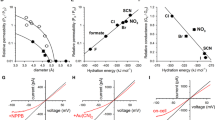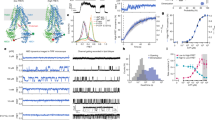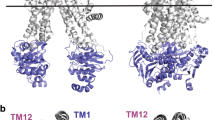Abstract
Ion channels play crucial roles in cell physiology, and are a major class of targets for clinically relevant pharmaceuticals. Because they carry ionic current, the function and pharmacology of ion channels can be studied using electrophysiological approaches that range in resolution from the single molecule to many millions of molecules. This chapter describes electrophysiological approaches for the study of one representative ion channel that is defective in a genetic disease, and that is the target of so-called highly effective modulator therapies now used in the clinic: the cystic fibrosis transmembrane conductance regulator (CFTR). Protocols are provided for studying CFTR expressed heterologously, for CFTR expressed in situ in airway epithelial cells, and for purified or partially purified CFTR protein reconstituted into planar lipid bilayers.
Access this chapter
Tax calculation will be finalised at checkout
Purchases are for personal use only
Similar content being viewed by others
References
Cohen SP, Haack KK, Halstead-Nussloch GE et al (2010) Identification of RL-TGR, a coreceptor involved in aversive chemical signaling. Proc Natl Acad Sci U S A 107:12339–12344
Haack KK, Tougas MR, Jones KT et al (2010) A novel bioassay for detecting GPCR heterodimerization: transactivation of beta 2 adrenergic receptor by bradykinin receptor. J Biomol Screen 15:251–260
Frizzell RA, Hanrahan JW (2012) Physiology of epithelial chloride and fluid secretion. Cold Spring Harb Perspect Med 2:a009563–a009563
Zhang ZR, Cui G, Zeltwanger S, McCarty NA (2004) Time-dependent interactions of glibenclamide with CFTR: kinetically complex block of macroscopic currents. J Membr Biol 201:139–155
Zhang ZR, Cui G, Liu X, Song B, Dawson DC, McCarty NA (2005) Determination of the functional unit of the cystic fibrosis transmembrane conductance regulator chloride channel. One polypeptide forms one pore. J Biol Chem 280:458–468
Machaca K, Qu Z, Kuruma A et al (2002) The endogenous calcium-activated Cl− channel in Xenopus oocytes: a physiologically and biophysically rich model system. In: Fuller C, Benos DJ (eds) Current topics in membranes: chloride channels of excitable and non-excitable cells. Elsevier Science, San Francisco, CA
Cui G, Zhang ZR, O’Brien AR, Song B, McCarty NA (2008) Mutations at arginine 352 alter the pore architecture of CFTR. J Membr Biol 222:91–106
Cui G, Khazanov N, Stauffer BB et al (2016) Potentiators exert distinct effects on human, murine, and Xenopus CFTR. Am J Physiol Lung Cell Mol Physiol 311:L192–L207
Cui G, McCarty NA (2015) Murine and human CFTR exhibit different sensitivities to CFTR potentiators. Am J Physiol Lung Cell Mol Physiol 309:L687–L699
Cui G, Stauffer BB, Imhoff BR et al (2019) VX-770-mediated potentiation of numerous human CFTR disease mutants is influenced by phosphorylation level. Sci Rep 9:13460
Cui G, Song B, Turki HW et al (2012) Differential contribution of TM6 and TM12 to the pore of CFTR identified by three sulfonylurea-based blockers. Pflugers Arch 463:405–418
Cui G, Hong J, Chung-Davidson YW et al (2019) An Ancient CFTR ortholog informs molecular evolution in ABC Transporters. Dev Cell 51:421–430
McCarty NA, McDonough S, Cohen BN et al (1993) Voltage-dependent block of the cystic fibrosis transmembrane conductance regulator Cl− channel by two closely related arylaminobenzoates. J Gen Physiol 102:1–23
Cohen SA, Hatt H, Kubanek J et al (2008) Reconstitution of a chemical defense signaling pathway in a heterologous system. J Exp Biol 211:599–605
Stauffer BB, Cui G, Cottrill KA et al (2017) Bacterial Sphingomyelinase is a state-dependent inhibitor of the Cystic Fibrosis Transmembrane conductance Regulator (CFTR). Sci Rep 7:2931
Infield DT, Cui G, Kuang C et al (2016) Positioning of extracellular loop 1 affects pore gating of the cystic fibrosis transmembrane conductance regulator. Am J Physiol Lung Cell Mol Physiol 310:L403–L414
Zhang ZR, Zeltwanger S, McCarty NA (2000) Direct comparison of NPPB and DPC as probes of CFTR expressed in Xenopus oocytes. J Membr Biol 175:35–52
Rowe SM, Pyle LC, Jurkevante A et al (2010) DeltaF508 CFTR processing correction and activity in polarized airway and non-airway cell monolayers. Pulm Pharmacol Ther 23:268–278
Mueller P, Rudin DO, Tien HT et al (1962) Reconstitution of cell membrane structure in vitro and its transformation into an excitable system. Nature 194:979–980
Parisi M, Reader TA, De Robertis E (1972) Conductance properties of artificial lipidic membranes containing a proteolipid from Electrophorus: response to cholinergic agents. J Gen Physiol 60:454–470
Hamill OP, Marty A, Neher E et al (1981) Improved patch-clamp techniques for high-resolution current recording from cells and cell-free membrane patches. Pflugers Arch 391:85–100
Linsdell P, Hanrahan JW (1996) Disulphonic stilbene block of cystic fibrosis transmembrane conductance regulator Cl− channels expressed in a mammalian cell line and its regulation by a critical pore residue. J Physiol 496:687–693
Acknowledgments
Supported in part by NIH predoctoral fellowship 1-F31-HL143863 (K.A.C.) and CF Foundation grant MCCART18G0 (N.A.M.).
Author information
Authors and Affiliations
Corresponding author
Editor information
Editors and Affiliations
Rights and permissions
Copyright information
© 2021 Springer Science+Business Media, LLC, part of Springer Nature
About this protocol
Cite this protocol
Cui, G., Cottrill, K.A., McCarty, N.A. (2021). Electrophysiological Approaches for the Study of Ion Channel Function. In: Schmidt-Krey, I., Gumbart, J.C. (eds) Structure and Function of Membrane Proteins. Methods in Molecular Biology, vol 2302. Humana, New York, NY. https://doi.org/10.1007/978-1-0716-1394-8_4
Download citation
DOI: https://doi.org/10.1007/978-1-0716-1394-8_4
Published:
Publisher Name: Humana, New York, NY
Print ISBN: 978-1-0716-1393-1
Online ISBN: 978-1-0716-1394-8
eBook Packages: Springer Protocols




